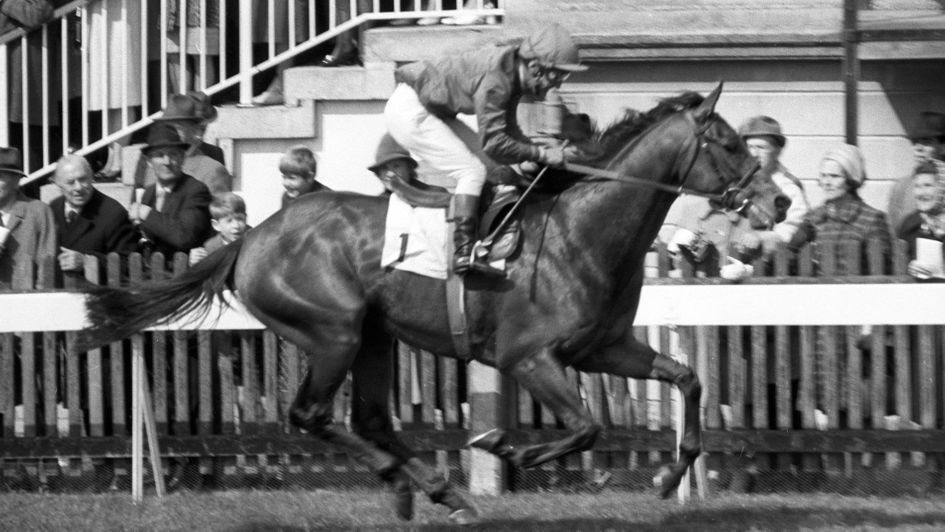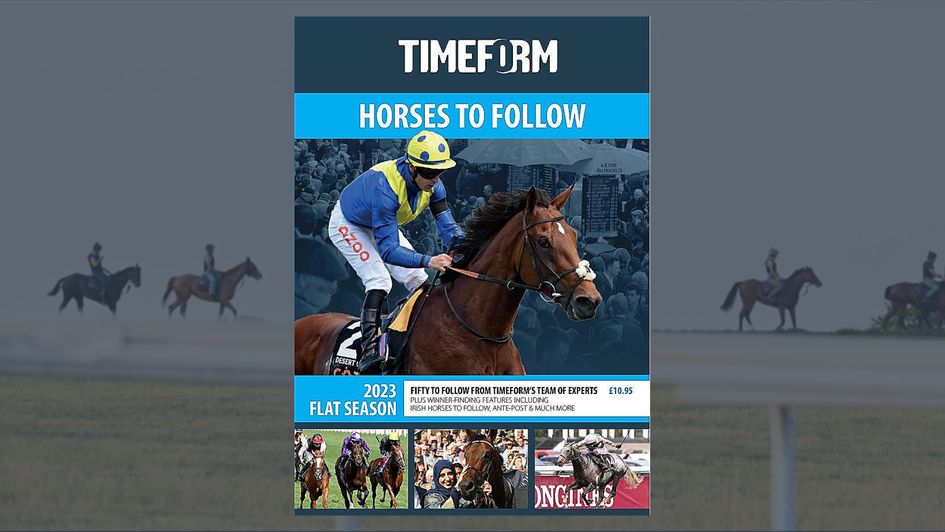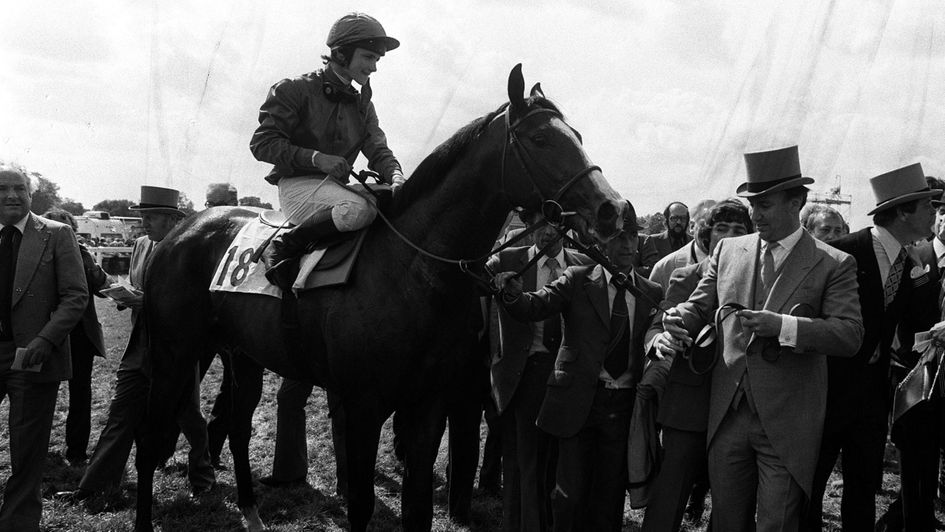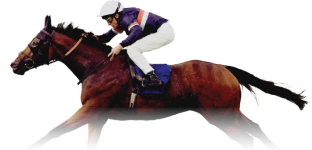Ahead of Brigadier Gerard night at Sandown on Thursday, read Timeform's profile of one of the greatest Flat horses of all time.
Brigadier Gerard won 17 of his 18 races and was the ‘British Horse of The Century’ according to ‘A Century of Champions’ by John Randall and Tony Morris, a book that covered the 20th century.
He proved himself capable of top-class form at a mile and a quarter and a mile and a half, but his finest performances were at a mile. Five races stand out – the 2000 Guineas, in which he beat Mill Reef and the previously unbeaten My Swallow, plus his runaway wins in the Sussex Stakes (by five lengths), the Goodwood Mile (by ten lengths) and the Queen Elizabeth II Stakes in 1971 (by eight lengths) and 1972 (by six lengths).
He was rated at 144, on a par with Tudor Minstrel (who won the 2000 Guineas by eight lengths in 1947), both just below the 1965 Derby and Prix de l’Arc de Triomphe winner Sea-Bird (145) until Frankel topped them all with a rating of 147 in 2012.
With such wide-margin successes, the task of assessing Brigadier Gerard’s worth was relatively straightforward because in most of his races he was made to show the full measure of his superiority over those he raced against – in the manner of Frankel or Shergar, rather than Nijinsky or Sea The Stars, who were ridden to win their races, not ridden to win them by as far as possible. Unlike Ribot, Sea-Bird, Mill Reef, Dancing Brave or Sea The Stars, who won races on foreign soil, Brigadier Gerard wasn’t tested outside his own country, but then neither was Frankel.
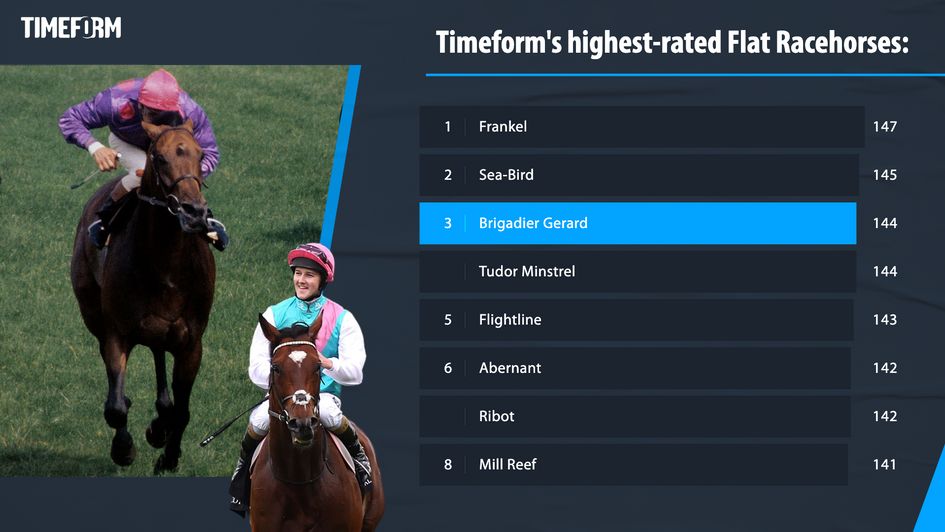
Two-year-old season (1970)
While Brigadier Gerard’s two-year-form didn’t quite match that of My Swallow and Mill Reef, he had a lighter season than either of those two and was unbeaten in four races.
He made his debut in the Berkshire Stakes over five furlongs at Newbury, eight days after Mill Reef had thrashed his rivals in the Coventry Stakes at Royal Ascot. Brigadier Gerard was backward and green but still much too good for his rivals, winning in style by five lengths from Mais’y Dotes.
The Champagne Stakes over six furlongs at Salisbury was won in similar fashion, this time by four lengths from Gaston Again with Comedy Star a neck further behind in third.
Comedy Star took on Brigadier Gerard again in the Washington Singer Stakes at Newbury six weeks later, but hadn’t done much in two races in the meantime to suggest he’d improved enough to trouble Brigadier Gerard, who was in complete command in the final furlong, beating Comedy Star by almost twice as far as the two lengths given by the judge.
There were five runners for the Middle Park Stakes at Newmarket. Favourite at 6/5-on was Mummy’s Pet, unbeaten in three races, including the Hyperion Stakes at Ascot and the Norfolk Stakes at Doncaster, the last-named contest now run as the Flying Childers Stakes. Second favourite was Swing Easy, who had won his first four races, including the New Stakes at Royal Ascot, the July Stakes at Newmarket and the Richmond Stakes at Goodwood before finishing three-and-a-half lengths third to My Swallow in the Prix de la Salamandre at Longchamp and who was reverting to six furlongs. Brigadier Gerard was next at 9/2.
It wasn’t until after halfway that the race began in earnest. Racing into the Dip, Brigadier Gerard held a narrow advantage over Swing Easy, with Mummy’s Pet looming up and looking dangerous on the outside. Just when it seemed Mummy’s Pet would take the lead, Brigadier Gerard quickened impressively, putting three lengths between himself and Mummy’s Pet at the post.
At the end of their two-year-old careers, My Swallow (134), Mill Reef (133) and Brigadier Gerard (132) headed both the Timeform ratings and the Free Handicap. Together, they lost just one of their 17 races, when My Swallow beat Mill Reef by a short head in the Prix Robert Papin at Maisons-Laffitte. My Swallow won seven races in all, including the Prix de la Salamandre and the Grand Criterium, to make a clean sweep of the top four races in France. After the Robert Papin, Mill Reef won three more races, including the Gimcrack Stakes at York (by ten lengths) and the Dewhurst Stakes at Newmarket (by four lengths).
Three-year-old season (1971)
1971 was a Flat season to remember, one blessed with the presence of two horses of the very highest class. That there should be a three-year-old, Brigadier Gerard, capable of thrashing his elders, such as Gold Rod, Dictus and Faraway Son, and extending his unbeaten record to ten was astonishing. That there should exist in the same country, in the same season, another three-year-old, Mill Reef, unbeaten in four top-class races after finishing second to Brigadier Gerard in the 2000 Guineas and having performances over longer distances of such a high order that many expected him to beat Brigadier Gerard the next time they met, almost strains credulity.
Which horse was the better? Timeform rated them both at 141 at the end of the season. The most salient facts were that no horse that season had form at a mile that could touch Brigadier Gerard’s, while no horse had form at a mile and a quarter and a mile and a half that could touch Mill Reef’s. It’s a fact that on their only meeting Brigadier Gerard beat Mill Reef handsomely in the 2000 Guineas, but there’s no doubt that Mill Reef improved over longer distances.
Only six lined up for the 2000 Guineas at Newmarket at the beginning of May, the fewest number of runners for the race in the 20th century – only in 1971, 1984 and 1988 did the race attract less than ten runners. Mill Reef had been the most impressive in his trial, winning the Greenham Stakes at Newbury by four lengths, and he started 6/4 favourite at Newmarket; next at 2/1 was My Swallow, who’d won the Usher Stakes at Kempton in April smoothly enough; followed at 11/2 by Brigadier Gerard, who was the only one of the six runners not to have had a trial.
My Swallow set the pace in the middle of the course, with Mill Reef sticking close to him as Brigadier Gerard tracked the pair. Brigadier Gerard was set alight running into the Dip and took command on the rising ground and, despite drifting left, strode away to win in very clear-cut fashion by three lengths from Mill Reef with My Swallow three-quarters of a length back in third. Possibly, the winning margin might have been less had My Swallow and Mill Reef been ridden with more restraint, but who could doubt the best horse at the distance had prevailed?
The principals in the Guineas never met again. My Swallow was second, beaten six lengths by Faraway Son, in the Prix de la Porte Maillot at Longchamp at the end of June and was finished for the season after another defeat, to Realm in the July Cup over a trip that would have been on the sharp side for him by that stage. Mill Reef, however, improved for the step up to middle distances, winning the Derby, Eclipse, King George and Arc.
After the Guineas, Brigadier Gerard started odds-on for all 13 of his subsequent races over the next two seasons. Just three took him on in the St James’s Palace Stakes at Royal Ascot and Brigadier Gerard started at 11/4-on. In heavy ground, Brigadier Gerard nearly lost his unbeaten record, needing every inch of the mile to prevail. On the turn into the straight with Sparkler in the lead, Brigadier Gerard’s regular jockey Joe Mercer was pushing along in second place and getting nowhere. He looked beaten until Sparkler, at last, began to weaken entering the final furlong, and Brigadier Gerard got up on the line to win by a head. After an even closer shave in the Champion Stakes, again on heavy ground, at the end of the season, it was announced that Brigadier Gerard would not be asked to race again in severely testing conditions.
While the ground for the Sussex Stakes at Goodwood in July was soft, it was not so testing, and Brigadier Gerard put up the finest performance in the race for a long time – until the first of Frankel’s two wins in the race in 2011. Brigadier Gerard ran top-class opposition off its feet, making all and quickening after six furlongs. He beat Faraway Son, the best four-year-old miler in Europe, by five lengths. Faraway Son’s defeat in the Sussex Stakes was his only loss in his last five races – after the Sussex Stakes he won three times at Longchamp, the Prix du Rond-Point, the Prix du Moulin and the Prix de la Foret.
In the Goodwood Mile a month later, only two took on Brigadier Gerard – Ashleigh and Gold Rod. Again, Brigadier Gerard led all the way, finishing ten lengths in front of Gold Rod. Even allowing for Gold Rod being eased, this was still an outstanding performance. Gold Rod won La Coupe de Maisons-Laffitte next time and then ran Faraway Son to half a length in the Prix du Moulin.
Brigadier Gerard faced the same number of runners next time in the Queen Elizabeth II Stakes at Ascot – Dictus and the luckless Ashleigh. The French-trained Dictus had won the Prix Jacques le Marois at Deauville from Sparkler on his previous outing but proved no match for Brigadier Gerard, who was again tremendously impressive, putting daylight between himself and his opponents from the home turn. Dictus was eight lengths behind him at the line, with Ashleigh another ten lengths further back.
To be no more than a miler, even one so outstanding as Brigadier Gerard, had its limitations in the 1970s. Victories in the top mile and a quarter and mile and half races would make Brigadier Gerard a more attractive proposition at stud. Greater fame and fortune was to be earned at the longer distances as well. Brigadier Gerard had won only £26,679 in his four races since the Guineas, whereas Mill Reef’s three wins in the Derby, Eclipse and King George had earned his connections £118,661. But would he stay a mile and a quarter? There had been no sign of Brigadier Gerard stopping at the finish of his races over a mile.
Finally, he was allowed to take his chance at a mile and a quarter in the Champion Stakes, back at Newmarket, 13 days after Mill Reef had sealed his season with a decisive victory in the Prix de l’Arc de Triomphe. The first prize money for the Champion Stakes, £25,280, was almost as much as Brigadier Gerard had earned in the St James’s Palace, Sussex, Goodwood Mile and Queen Elizabeth II put together. On Champion Stakes day the weather turned against Brigadier Gerard – so much so that he had everything to lose and little to gain (except, of course, the prize money). By the time the ten runners went down to the start the ground had become sodden, providing a more severe test of stamina for a horse on his first attempt at the trip.
Brigadier Gerard moved smoothly into the lead two furlongs out but he couldn’t get clear. Rarity stuck to him and failed by only a short head. Rarity, who had won two Group 3 races at the Curragh, including the Desmond Stakes by four lengths, was relatively fresh and he ran the race of his life at Newmarket, retired to stud after.
There are several explanations for Brigadier Gerard’s near-defeat, a performance that was more than 10 lb below his very best. He had been on the go since early in the year and could well have been past his best by October. There was also the chance that he didn’t feel inclined to race. He had shown a reluctance to go down to the start, and twice appeared as though he might dig his heels in and call it a day. In this connection, it could be of significance that before the Queen Elizabeth II Stakes he gave a miniature rodeo display before moving out onto the course.
Four-year-old season (1972)
The burning question before the start of the 1972 season was whether, on more suitable going than he encountered in the Champion Stakes, Brigadier Gerard would prove capable of reproducing his best form over a mile and a quarter? The distance at which it was widely anticipated that he would clash again with Mill Reef.
It wasn’t until 20th May that the ground had dried out to the liking of Brigadier Gerard’s connections, and he made his reappearance in the Lockinge Stakes at Newbury. His two-and-a-half-length win over Grey Mirage had a workmanlike look about it, especially compared to Mill Reef’s ten-length win in the Prix Ganay three weeks earlier.
Brigadier Gerard was out again nine days later, this time over a mile and a quarter in the Westbury Stakes at Sandown. Giving 10 lb and more to his four rivals, Brigadier Gerard was no certainty, and it wasn’t until inside the last furlong that he got on top and he had to fight hard to stay there. Ballyhot, whose only defeat in four races as a three-year-old had been when fourth to Brigadier Gerard in the St James’s Palace Stakes, was receiving a stone at Sandown and was only half a length behind the winner at the line.
Two days before the Prince of Wales’s Stakes at Royal Ascot, Joe Mercer was due to fly to France but the small plane crashed shortly after take-off and, as in the similar incident involving Frankie Dettori in 2000, the pilot was tragically killed. It was thought Mercer would miss Royal Ascot but he took the ride on Brigadier Gerard in the race and the pair impressed, racing to the front two furlongs out and soon going clear, winning by five lengths in course record time from Steel Pulse, who went on to take the Irish Derby 11 days later. However, Mercer felt unwell after the race, and missed the rest of the Royal meeting.
The clash between Mill Reef and Brigadier Gerard in the Eclipse was on, and after Royal Ascot the odds offered against Brigadier Gerard beating Mill Reef were shortened from 5/2 to 11/10 – Mill Reef had scrambled home by a neck in the Coronation Cup 12 days before the Prince of Wales’s. However, ten days before the Eclipse it was announced that Mill Reef would not run because he was ‘not quite himself’, the cause thought to be a viral infection affecting the stable.
With Mill Reef absent, the Eclipse had a second-team look about it with the exception, of course, of Brigadier Gerard. A torrential downpour made the ground soft at Sandown. Brigadier Gerard gave a little trouble in the paddock, on several occasions having to be cajoled into walking on after digging in his toes. The foul weather was reminiscent of that on Champion Stakes day the previous year, but Brigadier Gerard’s unbeaten record remained intact. He had the race won when he moved into a two-length lead, but he didn’t pull away. Although Gold Rod hung on grimly, Brigadier Gerard won a shade more cosily than the official one-length margin suggests.
Brigadier Gerard’s connections apparently had no doubts about his ability to stay a mile and a half as a four-year-old and he made a quick return to the racecourse to contest the King George VI and Queen Elizabeth Stakes at Ascot. Five of the nine runners in the King George field had won classics. As well as Brigadier Gerard, there was Riverman (Poule d’Essai des Poulains), Steel Pulse (Irish Derby), Gay Lussac (Derby Italiano and unbeaten in seven races), and Parnell (Irish St Leger). At the finish the classic winners filled the first five places.
Parnell helped force the pace with the Hardwicke Stakes winner Selhurst. Mercer allowed Brigadier Gerard to close up fast into second place behind Parnell approaching the home turn and the pair had the race to themselves in the straight. Two furlongs out, Brigadier Gerard drew alongside Parnell on that horse’s outside, but he then started to edge right. After taking up the running he kept straight for a short while before again veering in towards Parnell, whose jockey was forced to switch his mount just inside the final furlong, dropping at least two lengths behind Brigadier Gerard in the process.
As Parnell renewed his effort, the gap between them was shrinking visibly in the last 30 yards, the margin at the line a length and a half. After a 13-minute stewards’ inquiry it was announced that the placings would remain unaltered. The head-on camera patrol film showed that, although Brigadier Gerard edged to the right after taking the lead, there was sufficient room for Parnell to have staged a comeback on the rails. The patrol film also showed that at the same time Brigadier Gerard started to hang towards the rails, Parnell began hanging slightly to the left, something that was not apparent from the stands. This made Brigadier Gerard’s movement look worse than it was.
Brigadier Gerard’s success at Ascot had taken his winning sequence to within one of those of Ormonde and Ribot, who were unbeaten after 16 races. It was announced that Brigadier Gerard would contest three more outings, all in Britain, starting with the newly-instigated Benson and Hedges Gold Cup – now the Juddmonte International - at York. Meanwhile, Mill Reef was reported as moving "like his old self" and the "race of the century" was back on again.
Come the day, though, only four lined up against Brigadier Gerard and Mill Reef was not among them. A week before the race Mill Reef’s trainer, Ian Balding, announced that the horse could not be made ready in time after a minor injury. Even though Brigadier Gerard’s opponents included the first two in the Derby, Roberto and Rheingold, few forecast that they would give Brigadier Gerard much trouble on weight-for-age terms. Lester Piggott had given Roberto one of his most memorable rides in the Derby, beating Rheingold by a short head, but Roberto had been well beaten in the Irish Derby next time, whereas Rheingold had won the Grand Prix de Saint-Cloud.
Piggott evidently thought Rheingold was now the better horse and he chose to ride Rheingold at York. With Roberto’s jockey in the 2000 Guineas, Bill Williamson (controversially jockey off Roberto for Piggott in the Derby), having a prior engagement in Ostend, Roberto’s owner flew over the Panamanian jockey Braulio Baeza, five-times champion jockey in the United States, to partner Roberto. In the paddock Brigadier Gerard looked magnificent, and although he played up a little in the paddock, letting out a few bucks and kicks, he remained perfectly cool.
Baeza rode Roberto as he had never been ridden before, jumping him out to lead at a scorching pace with Bright Beam (Mill Reef’s pacemaker who was curiously left in the race after Mill Reef had been struck out). Roberto took over on the home turn with Brigadier Gerard soon moving into second place. However, three furlongs out it was clear all was not well with Brigadier Gerard and there was little response. With Roberto keeping up the strong gallop, Brigadier Gerard was beaten before the final furlong and ITV’s John Penney concluded his commentary with the words "Brigadier Gerard’s unbeaten record is absolutely smashed to smithereens". The margin was three lengths, though it would only have been two had Mercer not dropped his hands 50 yards from the finish. Gold Rod was officially ten lengths behind Brigadier Gerard in third – though the photo finish strip showed the margin to have been 17 - with Rheingold only fourth.
The Benson and Hedges was Brigadier Gerard’s third big race in a little over five weeks. In the King George he had a very hard race indeed and it’s possible that the race temporarily took the edge off him. Like Saratoga or Court Number Two at Wimbledon, York’s Benson and Hedges became known as the ‘graveyard of champions’. In the five runnings after Brigadier Gerard, another four odds-on favourites bit the dust in the race – Rheingold in 1973, Grundy (also after a gruelling race at Ascot) in 1975, Trepan in 1976 and Artaius in 1977. Later, a more plausible excuse for Brigadier Gerard’s defeat emerged: it was reported that shortly after the race he’d put his head down in the racecourse stables and mucus poured out of him.
It was nearly six weeks before Brigadier Gerard’s next race – a return to Ascot in the Queen Elizabeth II Stakes. By then, Mill Reef had suffered a career-ending injury and hopes of a meeting between the two were dashed. One of Brigadier Gerard’s rivals at Ascot was Sparkler, who was set to receive 7 lb from Brigadier Gerard – the race was a Group 2 with penalties at the time and wasn’t upgraded to Group 1 until 1987. Since the previous year’s St James’s Palace Stakes, Sparkler had won the Queen Anne Stakes at Royal Ascot and had gained a second successive win in the Prix Quincey at Deauville. The other two runners were the very smart three-year-old Redundant, successful in the Britannia Handicap at Royal Ascot, and Brigadier Gerard’s lead horse Almagest. Perhaps it was felt that the presence of the last-named in the field, and also in the subsequent Champion Stakes, might make Brigadier Gerard a little more relaxed in the preliminaries. Certainly, he was on his best behaviour in the paddock, but perhaps he was too relaxed as he completely missed the break, losing three or four lengths in a race run at a cracking pace.
Rousted along, Brigadier Gerard soon raced up to the others and he was going easily as the runners swung round the home turn. Piggott on Sparkler took up the running early in the straight and, looking over his shoulder, attempted to play cat and mouse with Mercer, but they had no answer to Brigadier Gerard’s acceleration once the latter took up the running over a furlong out. Although Sparkler and Redundant weren’t given hard races once held, the distances between the first three were six lengths and five. The final time for the race was a new course record, just over a second inside the old one, which had stood for 15 years; this was arguably the finest performance of Brigadier Gerard’s career.
Arrangements for the syndication of Brigadier Gerard had begun before the Benson and Hedges and shares in the horse were very quickly allocated. The Hislops reserved the right to settle Brigadier Gerard’s racing programme and, with the going on top after an unusually dry autumn, Brigadier Gerard was in the field for the Champion Stakes at Newmarket.
Three furlongs out, Brigadier Gerard, tucked in behind the leaders, was pulling double and he hit the front shortly afterwards. Without leaving anything to chance, Mercer soon began to hand ride Brigadier Gerard in an effort to get the colt to assert his superiority. Riverman, running for the first time since the King George, proved a much tougher nut to crack than the other seven runners. In the last furlong, Brigadier Gerard held on by a length and a half, his lead being whittled away as Riverman kept on well despite flashing his tail.
At the end of the season, Brigadier Gerard became the first to be unanimously voted Horse of the Year in the poll conducted by the Racegoers' Club.






